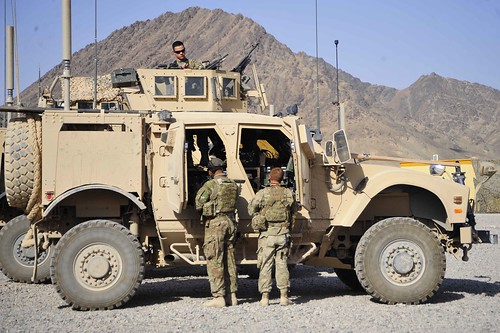Here's how foreign "aid workers" travel in Afghanistan:

FARAH, Afghanistan / U.S. Army Security Forces members of Provincial Reconstruction Team Farah gets his weapon ready to go on patrol to Farah Hospital, Farah City, Farah Province, Afghanistan, July 23. The Farah Director of Public Health and member of the PRT visited the hospital to assess the structure and working conditions. (ISAF Photo/ USAF SrA Alexandra Hoachlander)(Released) ISAF Media
New Secretary of Defense Leon Panetta knows what a war bureaucrat is expected to say when yet more deaths pile up:
Blah, blah, blah ..."Their courage was exemplary, as was their determination to make this a safer world for their countries and for their fellow citizens," Panetta in a statement.
"We will stay the course to complete that mission, for which they and all who have served and lost their lives in Afghanistan have made the ultimate sacrifice."
Last week the International Crisis Group published a blistering sample of "humanitarian" bureaucrat speak assessing development in Afghanistan after 10 years of NATO/US war and occupation.
Or, in plain English, for too many Afghans, we've made life worse, not better. Oh, but we did spend a lot of money on the project, mostly in bribes and contractor profits.After a decade of major security, development and humanitarian assistance, the international community has failed to achieve a politically stable and economically viable Afghanistan. ...
The amount of international aid disbursed since 2001 -- $57 billion against $90 billion pledged -- is a fraction of what has been spent on the war effort. More importantly, it has largely failed to fulfill the international community’s pledges to rebuild Afghanistan. Poor planning and oversight have affected projects’ effectiveness and sustainability, with local authorities lacking the means to keep projects running, layers of subcontractors reducing the amounts that reach the ground and aid delivery further undermined by corruption in Kabul and bribes paid to insurgent groups to ensure security for development projects....
As more and more districts come under Taliban control, despite U.S. claims of substantial progress, and the insurgency spreads to areas regarded until recently as relatively secure, displacement and humanitarian needs are also rising. The U.S.-led counter-insurgency doctrine that aid should consolidate military gains has been at best unsuccessful, if not counter-productive.
Quick impact stabilisation projects, whether civilian or military-led, in areas retaken from the Taliban have failed to enhance public trust in government. The blurring of lines between needs-based assistance and the war effort has also challenged the ability of non-governmental organisations (NGOs) to maintain their neutrality and independence and to operate in areas outside coalition and government forces’ control. As security deteriorates further, entire communities could be denied access to humanitarian assistance and basic services....
No comments:
Post a Comment